Creating stunning cacti borders in dry areas requires selecting drought-tolerant species like Prickly Pear and Golden Barrel. Prepare soil with cactus mix, coarse sand, and pumice for ideal drainage. Space plants 2-3 feet apart, arranging taller varieties at the back and shorter ones in front. Incorporate decorative rocks for visual interest and improved drainage. Water sparingly, allowing soil to dry between sessions. The right design principles and seasonal care techniques will transform your arid landscape into a striking natural boundary.
Numeric List of 12 Second-Level Headings

These twelve essential headings will structure your cacti border planning and maintenance process:
- Choosing the Right Cacti for Your Climate
- Soil Preparation for Ideal Drainage
- Creating a Visually Balanced Layout
- Proper Spacing Techniques
- Incorporating Decorative Rocks and Gravel
- Seasonal Watering Schedules
- Managing Pests and Diseases
- Pruning and Maintenance Tips
- Adding Companion Plants
- Enhancing with Lighting Elements
- Winter Protection Strategies
- Long-term Border Evolution
Each section guides you through establishing a thriving Cactus Garden that withstands challenging conditions.
Remember that soil that drains properly is fundamental to success—your carefully selected cacti will reward you with striking forms and occasional blooms.
Selecting Drought-Tolerant Cacti Species for Border Planting
When choosing cacti for your border, you’ll want to focus on low-water champions like Prickly Pear and Golden Barrel that survive with minimal irrigation once established.
Select border-friendly varieties with appropriate heights, such as the vertical Mexican Fence Post for barriers or shorter species for layered designs that create visual interest.
Your climate zone will determine which drought-tolerant options will thrive best, so consider your specific temperature extremes and rainfall patterns before making final selections.
Low-Water Champions
Desert gardeners seeking the perfect border plants need search no more than drought-tolerant cacti.
These low-maintenance champions thrive where other plants surrender to the elements, creating stunning borders while conserving precious water resources.
When designing your water-wise landscape, consider these top performers:
- Golden Barrel Cactus and Prickly Pear varieties establish quickly with minimal watering, creating dramatic focal points along borders.
- Mexican Fence Post Cactus offers striking vertical interest, standing sentinel through extreme temperature fluctuations.
- San Pedro Cactus combines drought tolerance with seasonal blooms, adding unexpected color to your arid garden.
- Native species like Coast Prickly Pear support local wildlife while requiring virtually no supplemental irrigation once established.
Border-Friendly Size Varieties
Five exceptional cactus varieties stand out for border applications in drought-prone landscapes. The Golden Barrel Cactus offers a compact, spherical form reaching only 1-2 feet, creating perfect low borders without obstructing views.
Partner this with the equally border-friendly size varieties like the Bunny Ear Cactus for interesting texture contrasts.
The versatile Prickly Pear thrives across hardiness zones 3-11, producing eye-catching blooms while maintaining manageable proportions.
When you’re seeking vertical interest, incorporate the Mexican Fence Post Cactus, which grows tall but stays slim, preserving space for companion plants.
For textural diversity, add the branching Ocotillo or San Pedro Cactus.
Remember to group specimens with similar water requirements, pairing drought champions like Agave Americana with equally resilient varieties for a cohesive, sustainable border.
Climate-Specific Selection Tips
Successful cactus borders depend largely on selecting varieties that naturally thrive in your specific climate zone and rainfall patterns. When choosing cacti species for your border, prioritize those that match your region’s conditions to guarantee they’ll flourish with minimal maintenance.
- Match hardiness zones carefully—opt for Golden Barrel Cactus in zones 9-11 and Prickly Pear in zones 3-10 for cooler areas.
- Select drought-tolerant varieties like San Pedro Cactus (Trichocereus pachanoi) for height and visual interest in dry landscapes.
- Incorporate native cacti species such as Coast Prickly Pear, which support local wildlife and adapt perfectly to regional conditions.
- Group cacti with similar water and sunlight requirements together to create sustainable, low-maintenance borders that thrive year-round.
Understanding Soil Requirements for Cacti Boundary Lines
While establishing an effective cacti border in dry landscapes, you’ll need to pay careful attention to soil composition and drainage. The ideal mixture combines commercial cactus mix, coarse sand, and perlite or pumice in equal parts, creating the well-draining environment that cacti require to thrive.
Before planting, test your soil’s drainage capabilities to prevent root rot. You’ll want to maintain a pH between 6.0 and 7.5 for peak nutrient absorption. If you’re dealing with clay soil, consider creating raised beds or mounds to enhance good drainage.
Don’t forget to top your cacti border with decorative stones or gravel. This final touch not only improves drainage but also helps regulate soil temperature, keeping your cacti healthy while creating a visually appealing boundary line.
Spacing and Arrangement Techniques for Effective Cacti Fencing

Creating an effective cacti border requires strategic spacing and thoughtful arrangement to achieve both security and visual appeal. When planning your living fence, proper spacing guarantees your cacti will thrive while creating an impressive boundary that defines your property.
- Position cacti 2-3 feet apart to accommodate mature growth and prevent resource competition while maintaining an effective barrier.
- Create visual interest through layering—place taller columnar varieties toward the back with shorter specimens in front.
- Integrate large rocks or boulders between cacti to enhance stability and provide aesthetic breaks in your arrangement.
- Ascertain cacti requiring full sun receive 6-8 hours of direct sunlight daily by mapping your border’s sun exposure before finalizing placement.
Incorporating Rocks and Gravel in Your Cacti Border Design
When selecting natural stones for your cacti border, choose varieties that mimic your local landscape to create an authentic desert aesthetic.
You’ll want to position larger rocks strategically as focal points, allowing smaller gravel to fill gaps and create natural-looking connections between plants.
This water-efficient arrangement not only enhances visual appeal but also improves drainage while reducing evaporation, helping your cacti thrive in dry conditions.
Natural Stone Selection
The foundation of a thriving cacti border lies in thoughtful stone selection. Your choice of natural stones affects both drainage and aesthetic appeal.
Angular rocks like granite and basalt interlock better than rounded stones, creating stable foundations that prevent soil erosion while allowing excess water to flow away from sensitive cactus roots.
- Size matters – Incorporate larger boulders as focal points, with smaller gravel filling gaps for a cohesive look.
- Local sourcing – Choose stones from your region for eco-friendly design that harmonizes with the surrounding landscape.
- Color consideration – Select gravel that contrasts with your cacti to highlight their unique forms and colors.
- Layering technique – Start with larger stones as anchors, then gradually shift to smaller gravel for a natural desert-like appearance.
Water-Efficient Arrangement
Skillfully arranging rocks and gravel in your cacti border transforms a simple planting into a water-efficient masterpiece. By strategically placing different-sized rocks among your cacti, you’ll create a natural desert aesthetic while establishing heat reservoirs that warm surrounding soil during cool nights.
Layer decorative stones atop your soil to prevent erosion and regulate temperature, creating stable conditions for cactus growth. This landscaping material serves dual purposes—enhancing visual appeal while minimizing moisture retention that could damage drought-sensitive plants.
Vary your gravel sizes to mimic natural desert landscapes where cacti thrive. This water-efficient arrangement reduces maintenance needs and promotes sustainability, especially in arid climates.
You’ll spend less time watering and more time enjoying your stunning cacti border as these hardy plants flourish alongside their rocky companions.
Combining Different Cacti Heights for Visual Interest
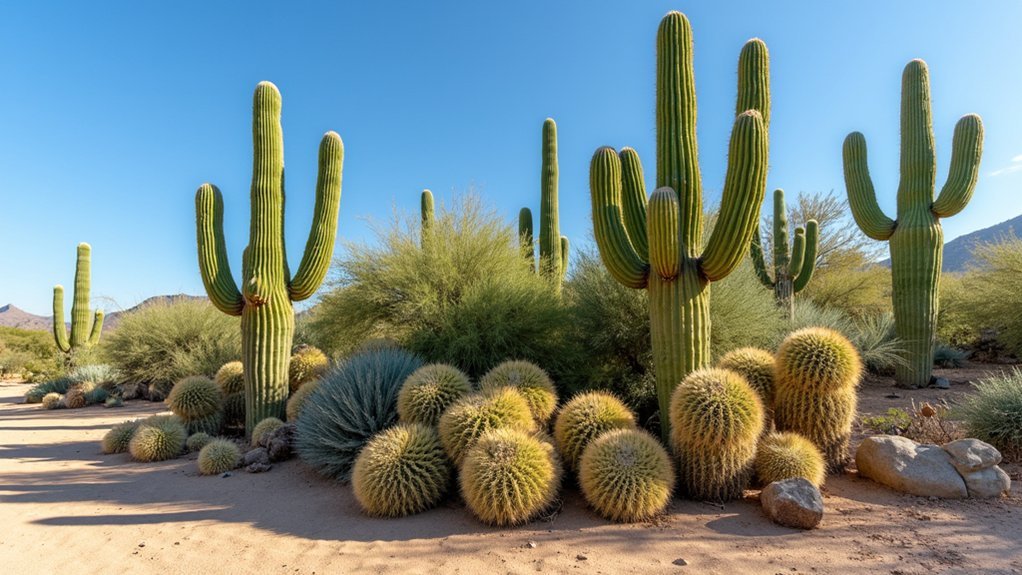
Why settle for a flat, monotonous cactus border when you can create an enthralling visual symphony with varying heights?
By strategically arranging cacti of different statures, you’ll transform your garden border into a dynamic desert landscape that captivates the eye.
Create height variation in cactus borders to transform ordinary gardens into mesmerizing desert vistas that demand attention.
- Position tall columnar varieties like the Mexican Fence Post Cactus as dramatic vertical accents to anchor your design and create immediate visual interest.
- Fill mid-level spaces with rounded specimens such as Golden Barrel Cactus to provide contrast and balance between tall and short elements.
- Soften the border’s base with low-growing Ocotillo Cactus, creating a natural shift and adding textural complexity.
- Stagger your cacti in an undulating pattern, considering mature growth sizes to guarantee every plant receives adequate sunlight while maintaining an aesthetically pleasing progression.
Seasonal Considerations for Maintaining Cacti Borders
Successful cacti borders demand attentive seasonal care to thrive throughout the year’s changing conditions.
During spring and summer, increase your watering frequency, allowing the top inch of soil to dry between sessions to prevent root rot. As fall and winter approach, reduce watering considerably as your cacti enter dormancy.
You’ll need to monitor temperatures carefully in colder months, providing frost protection for outdoor specimens, especially if you’re in zones below 8-10 where many cacti flourish.
These seasonal changes affect not only care requirements but also visual appeal—consider incorporating varieties that bloom at different times for year-round interest.
Don’t forget to check for pests and diseases more frequently during warm months when increased growth can attract unwanted visitors.
Prompt action will maintain your border’s health and beauty.
Watering Strategies for Established Cacti Fence Lines
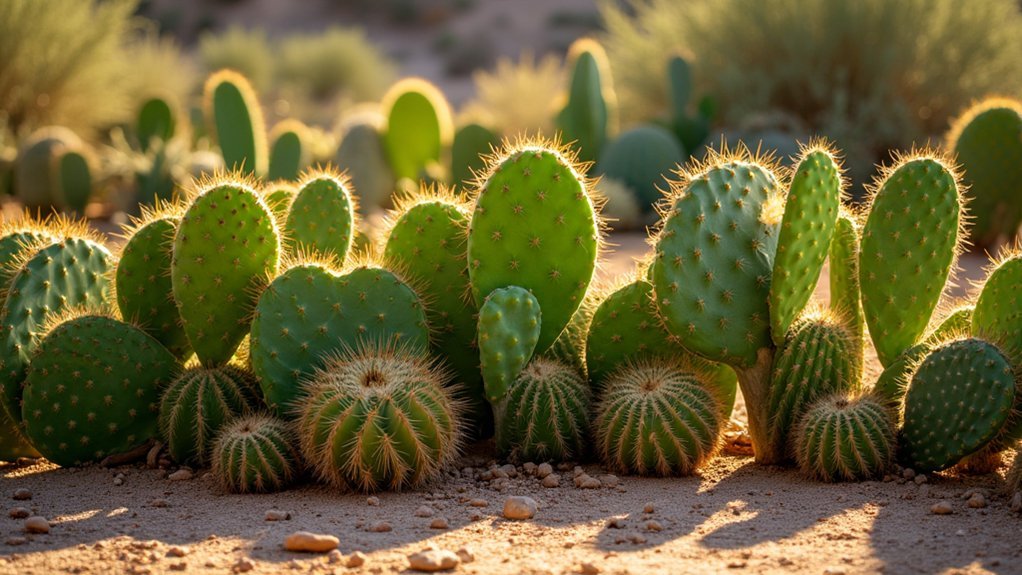
Once your cacti border has established itself, proper watering becomes critical to maintaining its health and visual impact.
Your established fence line requires a disciplined approach to hydration that respects the natural adaptations of these desert plants.
Desert plants demand discipline, not indulgence – respect their evolutionary wisdom through mindful watering practices.
- Water at the base of your cacti every few weeks during growing season, allowing the top inch of soil to completely dry between sessions to prevent root rot.
- Use a moisture meter in particularly dry climates to accurately monitor moisture levels rather than relying on visual cues.
- Reduce watering considerably during fall and winter dormancy periods when plants naturally conserve energy.
- Consider installing a drip irrigation system for your border that delivers water directly to roots without oversaturating the soil or wetting stems.
Adding Complementary Succulents to Enhance Border Appeal
While cacti create a striking boundary on their own, incorporating complementary succulents into your border design can transform a simple fence line into a breathtaking desert landscape.
Different types of cacti thrive alongside succulents like Aloe and Echeveria, creating varied textures and visual interest in your landscaping design.
Use low-growing succulents as groundcover beneath taller specimens to create a lush, layered effect. Select varieties that bloom at different times to guarantee year-round color.
For maximum impact, pair contrasting forms—spiky cacti against round-leaved succulents create dynamic tension.
Remember to group plants with similar water and sunlight requirements together. This simplifies maintenance while guaranteeing all specimens flourish in your arid environment, allowing your cacti border to become a stunning showcase of desert-adapted plants.
Creating Security With Thorny Cacti Varieties

You’ll find thorny cacti varieties create an effective prickly perimeter defense that deters both animal and human intruders while enhancing your landscape’s visual appeal.
Strategic placement techniques, such as planting Mexican Fence Post Cacti in rows or Golden Barrel Cacti along vulnerable entry points, maximize security without sacrificing aesthetics.
Incorporating height-varied barrier options, from low-growing Prickly Pear to towering Ocotillo specimens, creates layered protection that’s both functional and visually interesting.
Prickly Perimeter Defense
Nature’s own security system exists in the form of thorny cacti varieties that create formidable barriers around your property. When you’re looking to establish effective boundaries that don’t require constant maintenance, thorny cacti like prickly pear and hedgehog cactus offer both protection and visual appeal.
These drought-tolerant sentinels thrive in harsh conditions while keeping unwanted visitors at bay.
- Strategic placement – Install cacti at vulnerable entry points around your home’s perimeter
- Layered defense – Plant different heights and varieties for an impenetrable thorny wall
- Aesthetic security – Enjoy colorful blooms and interesting textures while maintaining protection
- Wildlife balance – Create habitat for beneficial creatures while deterring unwanted intruders
Strategic Placement Techniques
Strategic placement transforms ordinary cacti into an effective security system for your property. Position thorny cacti varieties like the Mexican Fence Post along your boundary at 2-3 foot intervals, allowing sufficient space for mature growth while maintaining a continuous barrier.
Create visual depth by arranging plants at varying heights—tall San Pedro cacti can tower protectively over shorter species, enhancing both aesthetic appeal and deterrent effect.
Select sunny, well-draining locations to guarantee your cacti thrive, strengthening their defensive qualities year-round.
For maximum security, incorporate diverse thorny varieties throughout your border. This not only adds visual interest but also creates a more formidable barrier against unwanted visitors.
Your strategic placement will transform these desert plants into a beautiful yet functional security barrier that complements your landscape.
Height-Varied Barrier Options
While enhancing your property’s security, a thoughtfully designed barrier of thorny cacti creates visual drama through strategic height variation. Thorny varieties like the Mexican Fence Post and Ocotillo reach impressive 10-foot heights, deterring intruders while adding striking landscape elements.
Cacti can be planted in staggered arrangements to create the perfect balance between security and visibility. Consider these landscaping ideas for maximum impact:
- Position taller cacti like the Ocotillo at strategic entry points where security is most needed.
- Intersperse medium-height varieties along the primary perimeter.
- Add Golden Barrel cacti as shorter front-row elements for textural contrast.
- Implement a zigzag pattern rather than straight lines to increase the barrier’s depth and effectiveness.
This approach guarantees protection while delivering year-round visual interest with minimal maintenance requirements.
Propagation Methods to Extend Your Cacti Border
Expanding your cacti border doesn’t require purchasing new plants—you can multiply your existing collection through several effective propagation techniques. With patience and the right approach, you’ll create a fuller, more diverse cacti border using plants you already own.
| Method | Difficulty | Time to Establish |
|---|---|---|
| Cuttings | Easy | 2-3 weeks |
| Offsets/Pups | Very Easy | 1-2 weeks |
| Division | Moderate | 2-4 weeks |
Remove offsets when they’re a few inches tall, ensuring they have developed roots before separating them from the parent plant. For cuttings, allow the severed pad to callous for several days before planting in well-draining soil. With clumping cacti varieties, division works well—simply separate the clumps into sections with roots intact and replant them along your border for expanded coverage.
Designing Curves and Corners in Cacti Boundary Plantings
Designing attractive curves and corners in your cacti border transforms a simple boundary into a enchanting landscape feature.
Thoughtfully crafted curves in your cacti border elevate garden boundaries into captivating focal points that define and enchant.
When planning these elements, you’ll want to work with the natural growth patterns of your cacti to create flowing lines that guide visitors through your garden.
- Mix tall columnar varieties with shorter cacti to create depth and visual interest along curved sections.
- Incorporate decorative rocks and gravel around curves to enhance drainage while highlighting the natural flow of your landscape design.
- Space plants according to their mature size, with larger specimens at the back of curves and smaller ones in front.
- Repeat similar curve patterns throughout your garden to create a cohesive landscape design that entices exploration and connects different areas.
Frequently Asked Questions
What Helps the Cactus Live in a Dry Place?
Your cactus survives drought with water-storing tissues, waxy skin that prevents evaporation, shallow extensive roots, nighttime gas exchange, and spines that provide shade and reduce air movement around the plant.
What Features Help Cactus to Survive in Dry Conditions?
You’ll find cacti survive dry conditions through their thick stems that store water, waxy skin preventing evaporation, widespread roots capturing rainfall, spines reducing water loss, and CAM photosynthesis that opens stomata at night.
Do Coffee Grounds Help Cactus?
Yes, coffee grounds can help your cacti when used sparingly. They improve soil drainage and add nitrogen, but don’t overdo it—excessive use increases acidity. Mix with sand or perlite and always use dried grounds.
How to Make a Cactus Flower Bed?
To make a cactus flower bed, you’ll need well-draining soil (1:1:1 potting soil, sand, perlite), various cacti species, a south-facing location with 6-8 hours of sunlight, minimal watering, and decorative gravel for aesthetics.
In Summary
You’ve now got all the tools to create a magnificent cacti border that thrives in dry conditions. By selecting appropriate species, understanding their needs, and following proper design techniques, you’ll enjoy a stunning, low-maintenance boundary that stands the test of time. Remember, your cacti border isn’t just practical—it’s a living sculpture that showcases your creativity while embracing the natural beauty of arid landscapes.

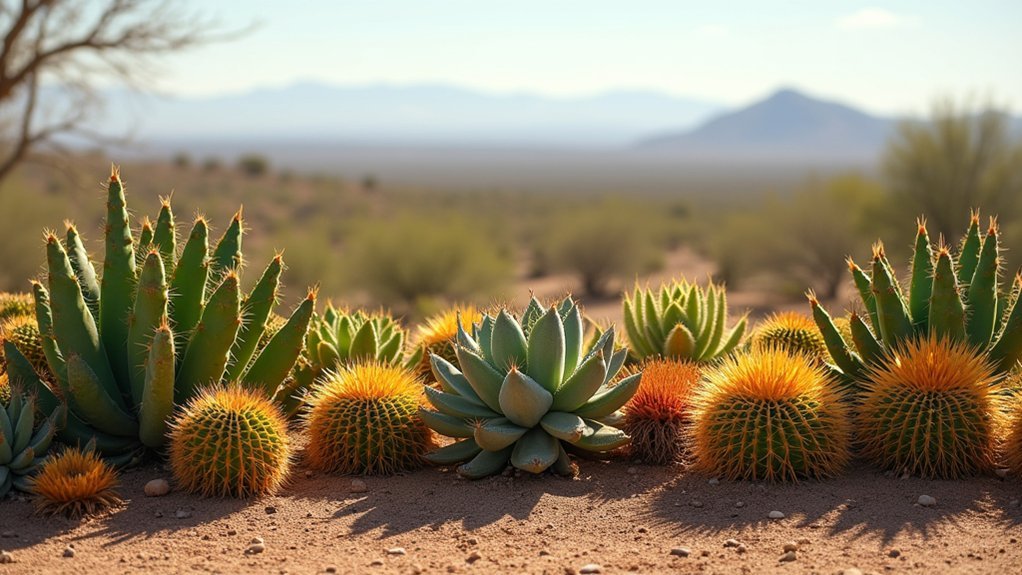

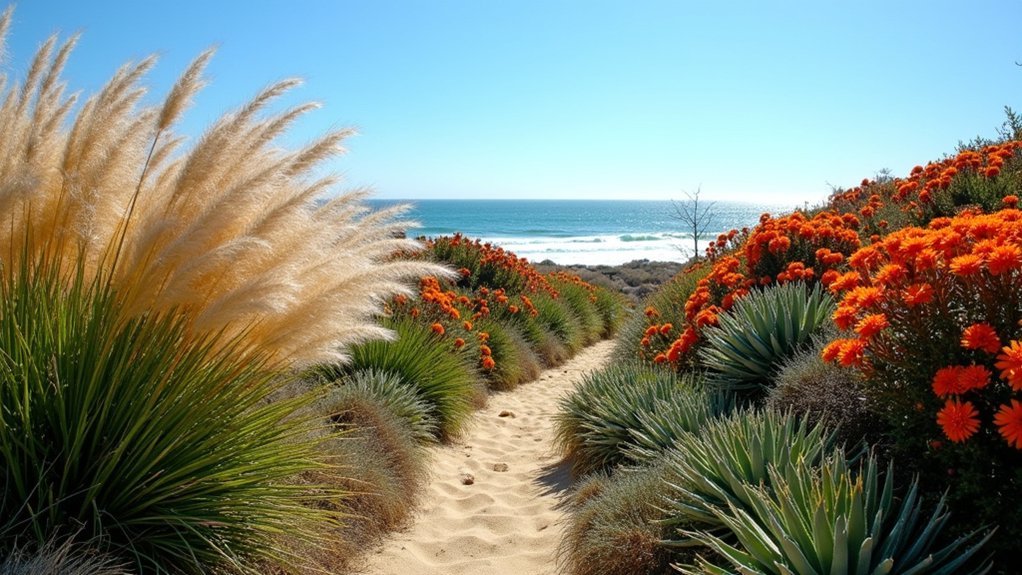
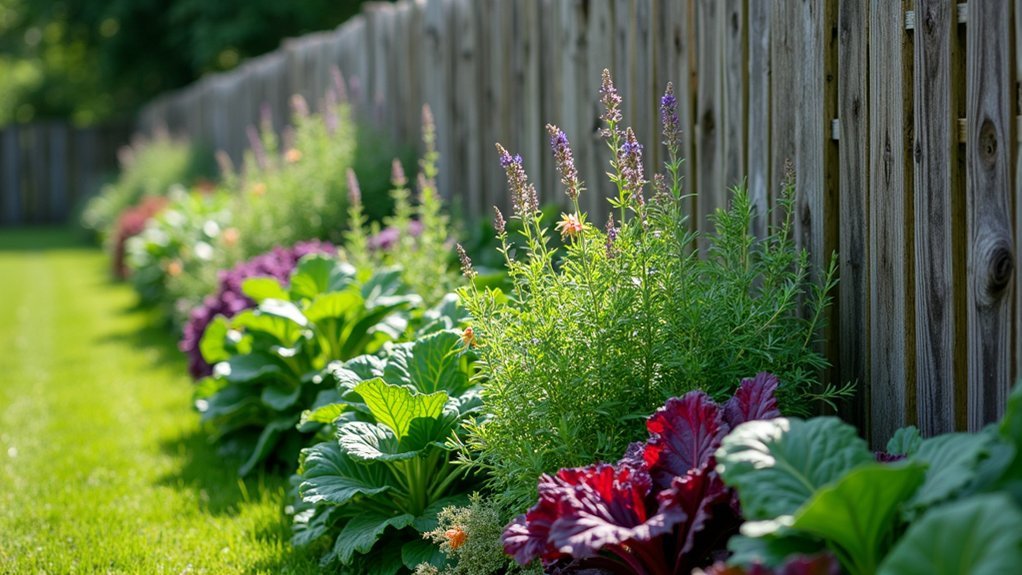
Leave a Reply